Landownership in South-West Down
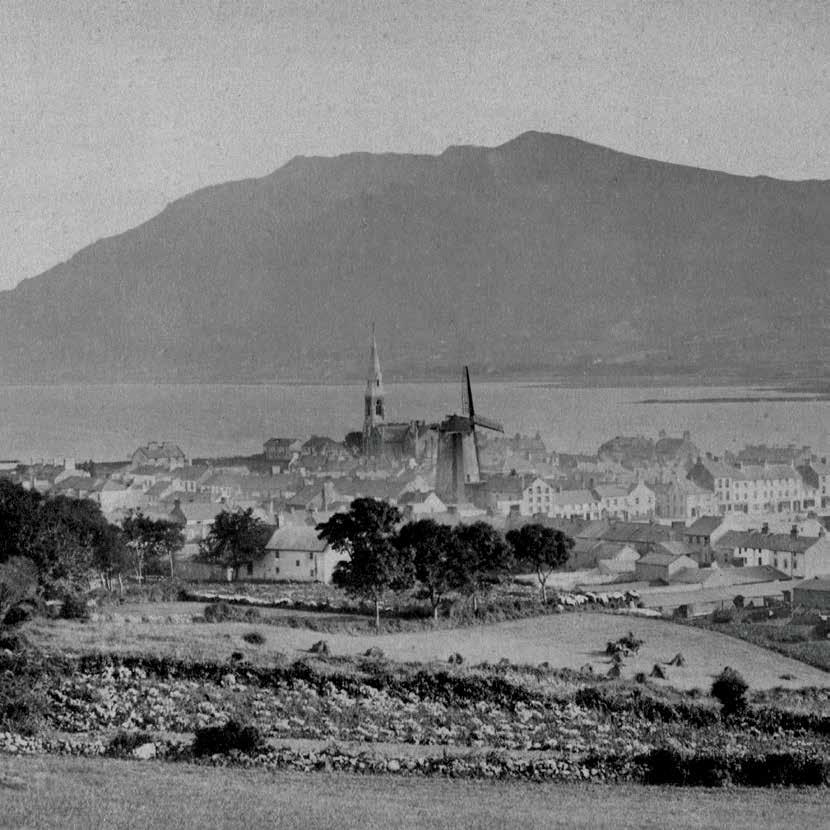
Front cover:
Warrenpoint and Carlingford Lough from the Bridle Loanan c.1900
This image shows the windmill which was located just off the Square and had been built by Robert Turner in 1802, the structure was 68ft in height and was a very valuable concern in the town.
Newry and Mourne Museum Collection
Narrow Water Castle
Narrow Water Castle was built in the 1560s at the cost of £361 4s. 2d. for an English garrison to protect an important crossing point at the head of Carlingford Lough. This image was taken in the late 19th century.
Newry and Mourne Museum Collection

Réamhrá an Mhéara
Gabhann an leabhrán seo le taispeántas earraí agus cáipéisí a léiríonn úinéireacht talaimh in iardheisceart an Dúin. Déanann an taispeántas iniúchadh ar an bhorradh a tháinig ar an Phointe, Ros Treabhair, Droichead Mhaigh Eo agus a leithéid de lonnaíochtaí agus baintear úsáid as seanléarscáileanna agus doiciméid mhaoine le stair na mbailte fearann a thabhairt chun solais, Baile Uí Thuathaláin agus Fionnúir san áireamh.
Tagann an chuid is mó de bhunábhar an taispeántais ó Chnuasach Reside, bailiúchán ollmhór d’fhoinsí cartlainne a bhaineann le stair dheisceart an Dúin a bronnadh ar Iarsmalann an Iúir agus Mhúrn sa bhliain 2002. Tugann an chartlann le fios saol oibre agus spéis i stair na háite a léirigh an Mhaor G.W. Reside, ailtire ar an Iúr agus a bhean chéile Margaret Reside (née Fisher), nach maireann, aturnae sa cheantar seo.
Tugann an taispeántas léargas dúinn ar shaibhreas an ábhair atá sa Chnuasach; déanann an dá alt sa leabhrán cur síos ar ghnéithe áirithe dá luach mar acmhainn thaighde ar stair áitiúil agus theaghlach.
Ba mhaith liom mo bhuíochas a ghabháil le gach duine a bhí páirteach sa taispeántas seo, rud atá lárnach d’aidhm na hiarsmalainne: a cuid bailiúchán a chur ar fáil do phobal an cheantair agus do chuairteoirí.
An Comhairleoir Michael Ruane Méara Chomhairle an Iúir agus Mhúrn
Mayor’s Foreword
This booklet accompanies an exhibition which looks at landownership in south-west Down through documents and artefacts. The development of Warrenpoint and Rostrevor is examined in the exhibition, while other settlements such as Mayobridge and townlands including Ballyholland and Finnard are explored through early property maps and documents.
The bulk of material on display comes from The Reside Collection, a large collection of archival material relating to the history of south Down which was donated to Newry and Mourne Museum in 2002. The archive reflects the working lives and interest in local history of the late Major G.W. Reside, an architect in Newry, and his late wife Margaret Reside (neé Fisher), a local solicitor.
The exhibition showcases the wealth of material contained in the Collection, while the two articles in this booklet amplify aspects of its value for local and family history research.
I would like to thank everyone involved in this exhibition which forms an important part of the Museum’s aim to make its collections accessible to the local community and visitors.
Councillor Michael Ruane Mayor, Newry and Mourne District Council
1
1
Lease map, 1886
From a lease from Albert Stratford George Canning to Joseph Weir of a portion of land in the townland of Rostrevor, for a term of seven years at rent of £251 per year, with permission to quarry, erect buildings for works, roads and watercourses. Newry and Mourne Museum Collection

2
Introduction
During the Middle Ages the two dominant landholders in south-west Down were the Cistercian Abbey at Newry and the Magennis lords of Uí Eachach Cobha (Iveagh). The abbey at Newry had been founded in 1153 possibly on the site of an older monastery. A charter of 1157 issued by Muirchertach Mac Lochlainn, king of Cenél nÉogain, conferred lands and privileges to the abbey. These lands included townlands such as Ballyholland, Crobane, Croreagh, Carnmeen and Castle Enigan.
The Reformation and government policy changed the landscape of landownership in south-west Down in the 16th and early 17th centuries. The Cistercian abbey at Newry was dissolved and its estates granted to Nicholas Bagenal, an English settler, in 1552. The lordship of Iveagh was divided into a number of freeholds whereby the Magennises held their land under a system of English land tenure. Many of the minor Magennis lords experienced financial difficulties in the aftermath of the Nine Years War and some of their land was acquired by English soldiers and adventurers. For example, Edward Trevor from Wales, began to build up an estate in County Down, and by 1635 had acquired nine townlands in the parishes of Clonallan, Kilbroney and Drumgath. In 1670 Francis Hall bought land around Narrow Water which originally had been part of the Magennis estates. The Hall family had come to Ireland around 1604, and settled at Red Bay, County Antrim.
The Hill family, which had settled at Hillsborough, purchased the townland of Carneyhough from the Crilly family in the 1690s.This eventually led to the
expansion of Newry as a major commercial town. Branches of the Ross family were associated with Rostrevor from the early 18th century onwards. In the 18th century the family at various times represented Newry in the Irish Parliament in Dublin.
Under the patronage of the Hall and Ross families, Warrenpoint and Rostrevor, developed. The aftermath of the Great Famine in the mid 19th century had a detrimental effect on the finances of many landed estates throughout Ireland. Estates were sold, including the Ross estate in 1850. The introduction of the Irish Land Acts in the later 19th century further transformed landownership by facilitating the transfer of land from the landlords to their tenants. This also allowed new families to acquire property and build up small estates.
Interior of Woodside Skating Rink, Rostrevor Described in Shaw’s Guide as, ‘… the only one in the neighbourhood, is quite an “institution”, in the place. It is supplied with Plimpton’s roller skates.’
From Shaw’s Tourist Picturesque Guide to Carlingford Bay and the County Down (1877)

3
Warrenpoint, 1772

Engraving titled ‘A view of Carlingford Harbour and Warrinpoint from the Domain of Roger Hall Esq. near Narrow Water’. The image shows Warrenpoint in its very earliest stages of development with newly built premises in the distance situated close to the dock.
Courtesy of Linen Hall Library, Belfast
4
The origins and development of Warrenpoint _ Shane McGivern
Newry and Mourne Museum holds an extensive archival collection which sheds light on many aspects of local history. One of the highlights of the Museum Collection is the Reside Collection which contains documents dating from 1715 up until the end of the 20th century. This article examines the development of Warrenpoint in the 19th century using a selection of the sources found in the Museum Collection.
Origins
Warrenpoint is a relatively new town and is an interesting example of 18th century town planning. The earliest document relating to Warrenpoint in the Reside Collection dated 1759 between Roger Hall and Ambrose Cramer, Collector of his Majesties Revenue in the Port of Newry. The document refers to two acres of land in ‘the town and lands of Ringmacilroy (commonly known as Warringspoint)…together with free passage and liberty of ingress and regress for men, horses and carriages to and from the great road leading from Narrowwater to Rostrevor.’ Walter Harris’ book, The Antient and Present State of the County of Down, published in 1744, called the area Waring’s Point and noted it as being at the entrance to the Newry River. Harris also noted the ferry boats which maintained communication between Counties Down and Louth and a salt works owned by Dr. Pullein. This may refer to an ancient salt works located at Green Island which was the property of Hugh Campbell by 1820. Narrow Water Castle had also been converted to be used as a salt works by the year 1811 as it was referred to in the
Belfast News Letter on May 28th ‘A constant supply of salt, best quality is now on sale at the salt works Narrow Water Castle, where every accommodation and dispatch will be given in loading vessels and carts. John Overam, Agent.’
Town Planning
Warrenpoint began to develop as a town after 1767 with the building of a tidal dock, funded by the Irish Parliament. Roger Hall, Robert Ross, Robert Scott and Edward Corry were appointed as commissioners and the dock subsequently became property of the Hall family. The town of Warrenpoint was planned and built around the new dock.
Savage Hall’s son Roger, (later known as the ‘Old Squire’), took over the estate and began to develop Warrenpoint as a seaside resort. By 1820, Warrenpoint had grown quite rapidly with the majority of businesses being public houses, lodging houses and grocers. People were employed as tidewaiters (harbour customs officials), ship builders, carpenters, captains, chandlers, mariners and boatmen. In 1824, Warrenpoint was described as a ‘small but rapidly improving town… contains a large number of lodging houses for the accommodation of visitors, hot and cold baths, and an excellent inn’.
Expansion
In the 1830s, the town had expanded further and contained a total of 462 houses, the majority of which were described as two storey and well built. The town’s expansion was attributed at that time by Samuel Lewis to the ‘extraordinary beauty of its
5
situation, commanding very fine views of the bay of Carlingford, and to its convenience as a bathing town’. The First Edition Ordnance Survey map of the town of Warrenspoint in 1835 shows substantial development since 1800, Duke Street, Charlotte Street and Church Street had all been developed with houses and business premises. Housing had been built along what is today called Osbourne Terrace. The Roman Catholic and Church of Ireland churches and the Methodist and Presbyterian Meeting Houses had been constructed for the growing population of the town.
Railway town and the Famine
The 1840s saw further commercial development of Warrenpoint. In 1845, a Patent Slip was constructed for the building and repair of vessels. The Patent Slip was later described in 1877 as the most ‘complete thing of its kind in Ireland, and lately several yachts and coasting vessels had been launched from it.’ In 1846, an Act was passed for the construction of a railway between Newry and Rostrevor with a branch to Warrenpoint.
The six mile line was opened May 28th 1849 and ran between Kilmorey Street in Newry to Newry Street in Warrenpoint but never went as far as Rostrevor. A horse drawn tramway linked the Great Northern railhead at Warrenpoint with Rostrevor between 1877 and 1915.
In the 1850s, following the aftermath of the Famine, Warrenpoint like the rest of Ireland suffered from the effects of the downturn in the economy. Many landed estates were no longer viable and had to sell off land in order to raise money to remain solvent. This led to the establishment of the Encumbered Estates court which was set up in 1849 to sell estates on the application of the owner. In order to attract potential buyers, detailed catalogues which contained information on the tenants and the land to be sold were produced. A number of these catalogues for Warrenpoint and Rostrevor can be found in the Reside Collection.
Buildings along the Shore Road (later Havelock Place), Warrenpoint, 1841 Taken from a plan of the property of George Godfrey Ogle in Warrenpoint. Newry and Mourne Museum Collection

6
Plan of proposed pier at Warrenpoint Dock, 1865
This hand drawn plan shows two alternative locations for a new pier at Warrenpoint in 1865. Plan A was proposed by The Newry and Greenore Railway Company whilst Plan B was proposed by Major Hall of Narrow Water. Newry and Mourne Museum Collection

7
Seaside resort
In the late 19th century, there were seven hotels in Warrenpoint town to accommodate the large influx of tourists during the summer season. In 1876, J.F. Small described Warrenpoint as being highly important in the ‘eyes of the health-seeking and pleasure-loving denizens of Newry’. A fascinating tourist book entitled ‘Shaw’s tourist picturesque guide to Carlingford Bay and the County Down’ from 1877 provides further insight into the town of Warrenpoint which attributes the town’s success to it being the terminus of the railway and the travel facilities afforded by the horse drawn car service of Messrs. Norton and Shaw.
Although it was a seaside attraction, there was also an industrial element to the town with McClelland’s coach builders, Hunter’s ship building yard, Greer’s Corn Mill and also a busy port which mainly dealt with exporting cattle and importing coal. The town had developed greatly in a relatively short space of time and by the end of the 19th century, Warrenpoint had been transformed from a small settlement to a successful commercial centre and a popular tourist destination.
Warrenpoint in the 20th century
In the first half of the 20th century, Warrenpoint continued to be a popular destination for tourists and day trips. Evidence of the town’s popularity can be found in a document from the Reside Collection which recorded passenger numbers from organised excursions to Warrenpoint in the 1924 summer season. The document records a total of 39,145 passengers as having visited the town. These people came from Newry, Dundalk, Dublin, Belfast, Dungannon and Derry which gives an idea of how well connected Warrenpoint was with the rest of Ireland. The closure of the Newry to Warrenpoint line in January 1965 coupled with the increased popularity and accessibility of foreign holidays saw a decline in Warrenpoint as holiday resort. Its role however as a port became more influential with the closure of the Newry Ship Canal in 1974 when all international shipping trade was transferred from Newry to Warrenpoint port which has continued to expand. Warrenpoint today remains a highly popular summer resort for day trips and has retained much of its character from when it was first planned in the late 18th century.

8
Postcard, c.1930
This view of the seafront at Warrenpoint shows the hotels and cafes which had been established in the early 20th century and the many boats that came across from Omeath during the summer months.
Newry and Mourne Museum Collection
The Promenade, Warrenpoint, c.1900
The promenade, with the bandstand and impressive seafront buildings, had been developed under the patronage of the Hall family in the 19th century. Newry and Mourne Museum Collection

9
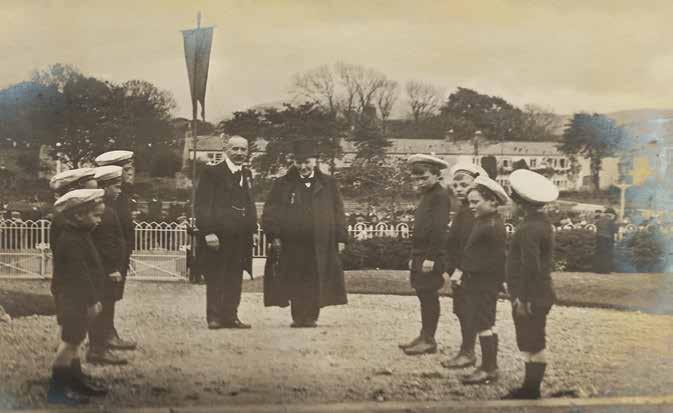
10
Opening of Warrenpoint Municipal Gardens
Warrenpoint Urban District Council obtained land from Captain Roger Hall of Narrow Water Castle for a park in December 1906. Newry and Mourne Museum Collection
Newspaper Supplement
Laying of the foundation stone of Warrenpoint Municipal Baths by Mrs Roger Hall of Narrow Water Castle. The Baths were opened in June 1908. Newry and Mourne Museum Collection
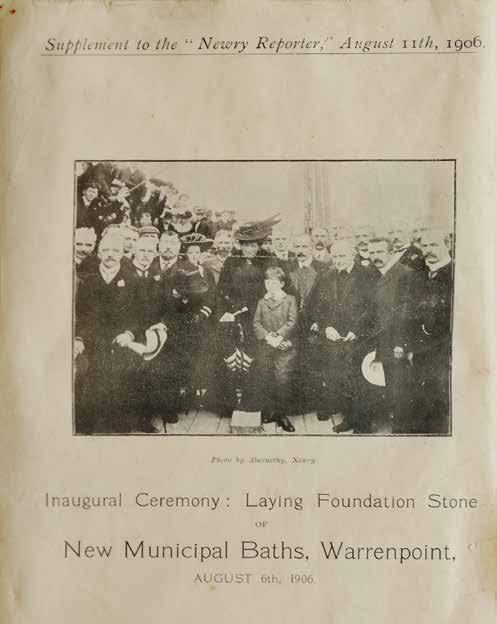
11
1810 Valuation and survey of the Rostrevor Estate
Dr. Terence Dooley
This valuation and survey pertains to the estate of Robert Ross (1766-1814) at Rostrevor in County Down and dates to 1810. It forms part of the Reside Collection in Newry and Mourne Museum. A much larger collection of family papers are on deposit in the Public Record Office of Northern Ireland.1
Major General Robert Ross was born in Dublin in 1766, the second of three sons whose father, Major David Ross, was also a career army officer. His mother, Elizabeth, was a half-sister of the 1st earl of Charlemont. Having been educated at Trinity, where he received his B.A. in 1789, Robert received a commission as an ensign in the 25th Regiment of foot and this began a very distinguished career in the British army.
As part of his mother and father’s marriage settlement it was agreed that any monies which his mother became entitled to in her own right were to be divided equally amongst her three sons. She inherited £36,000 and so Elizabeth and her husband invested the same in the purchase of lands at Rostrevor and the Ards peninsula, as well as a house in the spa town of Bath in England. However, in his will, Major David Ross left all of the estate to his eldest son. The will was then contested by Elizabeth on behalf of herself and her other children. In 1796, Major David’s will was declared invalid by the Court of Chancery and so Robert received one third of the estate. Then in 1809, for whatever reason, this estate
1 See T.3420 and D2004/4/25.
was again divided between him, his elder brother, Rev Thomas Ross (then a rector at Clifton, near Bristol in England) and Rev Samuel Blacker, their brother-in-law.
Part of Robert’s share was the Rostrevor estate. Because of his army career, little is known of him as a landlord and, in fact, it is unlikely that he had an opportunity to spend much time there. However, he did have ambitions to build a country house on the estate and the survey and valuation illustrates that he had an interest in the estate’s management from shortly after the time he took ownership.
It would make sense that upon inheriting this property in 1809 Robert would employ a professional surveyor, Pat O’Hare, to value and survey his lands. Survey and valuations were sometimes carried out by the landlord and/or agent but more typically, as in this case, by a professional valuator. Unfortunately, no biographical details were found on Pat O’Hare, but presumably he owned an estate valuation (or perhaps land agency or solicitor’s) office in one of the neighbouring towns. By employing O’Hare, Ross would have wanted to know who exactly was living on his estate, how much land each occupier held - and not all occupiers were necessarily individuals, some of those were listed simply as ‘Paper Mill farm’ and ‘Barrack Green’ - what rent they were paying, and, probably most importantly from his perspective, was the land being let at market value or could it be better exploited to his advantage.
Typically, therefore, this valuation sets out the names of tenants in each townland, the size of their holdings in Irish acres, the valuation of the tenancy, and the tenurial arrangements pertaining to each. Thus, we learn that in ‘Rosstrevor West’, there were eleven
12
tenants holding between them an aggregate of just over sixty-eight acres. Holdings were small, on average just over 6 acres, ranging from the largest at just over fourteen acres to the smallest at just over two. Ten of the tenants held ‘at will’, meaning essentially that the tenant occupied the land with the consent of the landlord but for no legally specified period of time. It has been estimated that by the Famine (1845-51) probably as many as 75 per cent of tenants held on this rolling yearly basis which could be terminated by either tenant or landlord on six months’ notice. The massive population explosion after 1800 had given rise to the growing prevalence of such tenancies. James S Donnelly Jr has pointed out that ‘Rarely did middlemen or landowners consider such poor and usually careless tenants worthy of a lease, at least after 1815.’2
Thus, rather typically for the time, there were only a few leaseholders on the estate usually holding for ‘three lives’ (the lives of three people named in the lease, some for ever, and others for 999 years.) O’Hare had obviously been instructed to ascertain the ages of those named in various leases – those named in William Kerr’s lease of ‘Rosstrevor’ were found to be aged 30, 25 and 24 – so as, presumably, to be able to gauge how long more the lease would last.
Valuations such as this tended not to be carried out too frequently on Ulster estates. This may have been due to the widespread existence of the so-called Ulster Custom. This custom is extremely difficult to define, but W.H. Dowling in his book Tenant right and agrarian society in Ulster 1600-1870 describes it as follows:
…a practice by which rural tenants claimed property rights above and beyond their contracts with landlords, allowing departing tenants to exact a payment well in excess of the yearly rent from those who wished to release them. Tenant-right payments not only compensated departing tenants for the improved value of their farms, they also served to transfer their ‘goodwill’ to the new occupier, thereby allowing the latter to enjoy the ‘peaceable possession’ of the farm.3
Valuations tended only to be carried out when an heir came of age, when the majority of existing leases were due to fall in or when, as in this case, a new owner took possession.4 The infrequency of valuations and the granting of long leases obviously provided tenants with a better sense of security in their tenureship and more confidence to carry out improvements. A tenant would have been much less inclined to invest in improvements if he did not have a decent term. Thus, the twenty-one year lease had become popular from the late nineteenth century and in 1811, just a year after the Ross valuation, the agent on the Anglesey estate in neighbouring County Louth argued:
Since the prospect of a certain tenure has been held out, twenty-one years and one life, a general spirit of improvement is manifested throughout the estate. But to promote that to any extent and to induce them to pay an increase of rent
2 James S Donnelly Jr, Landlord and tenant in nineteenth-century Ireland (Dublin, 1973), p. 20
3 W.H. Dowling, Tenant right and agrarian society in Ulster 1600-1870 (Dublin, 1999), p. 3.
4 Terence Dooley, The big houses and landed estates of Ireland: a research guide (Dublin, 2007), pp 76-77.
13
Property map, 1818
Shows property owned by Samuel Wilson in the area of Mary Street, Rostevor. Newry and Mourne Museum Collection

14
cheerfully, a term not shorter than one life and twenty-one years is indispensable.5
Leases are important for what they reveal about the management of an estate and the agricultural practices thereon.
The dating of this survey and valuation is probably revealing. In 1810 the country was still in the midst of an economic boom characterised by the inflation of property values, the rise in agricultural output, and increased landlord and tenant prosperity. Thus, in the late eighteenth and early nineteenth centuries many landlords employed surveyors to provide an overview of their estates, and so while Ross was a career officer in the army, he still saw the benefit of a rental income to his personal finances and he had the ambition to build a country house on his retirement.
The typical survey and valuation would often have been accompanied by a map, although in this case no map seems to have survived. The survey set out the boundaries of a property, measuring it in acres, delineating individual holdings, often giving their valuation and rental, identifying roadways, plantations and so on. Thus, the landlord is provided with information on tenants, their holdings and the rents they paid, and what possibilities existed for increasing the rental capacity of the holding in the future. With the proper information to hand, the landlord could then devise his estate management strategy.
Lease map, 1821 Shows plots of land with measurements held by tenants in Mary Street, Rostrevor.

Newry and Mourne Museum Collection
5 Quoted in Dowling, Tenant right and agrarian society in Ulster, p. 287.
15
In the years after 1810, at a time of global conflict, Ross served in North America and came to prominence at the time for leading the attack on Washington during the War of 1812. 6 Two years later, during the British attack on Baltimore on 12 September 1814, he was shot in the arm, the bullet passed into this chest and he died shortly afterwards. He was buried in St Paul’s cemetery in Halifax, Nova Scotia. Monuments were subsequently erected to him in St Paul’s Cathedral in London and Kilbroney parish church in County Down. In 1826, his co-officers of the American campaign and the landed gentry of County Down joined to erect a granite obelisk on his Rostrevor estate where he had intended to build his country house after the wars.
Extract from the Valuation and Survey of Rosstrevor Estate, 1810 Shows the section of the valuation listing the tenants on demesne of the estate.

Newry and Mourne Museum Collection
6 For more details see, W.A. Maguire, ‘Major-General Robert Ross and the burning of Washington’, The Irish Sword, xiv, no. 55 (1982), pp 1-12; see also ‘Major General Robert Ross (1766-1814)’, http://www.newulsterbiography.co.uk/index.php/home/ viewPerson/1902, viewed 19 Nov. 2013.
16
Contributors
Shane McGivern is Collections Research Assistant at Newry and Mourne Museum. This post is funded by Newry & Mourne’s contributions to the Landfill Communities Fund administered by Ulster Wildlife. Shane holds a First Class BSc Honours Degree in Archaeology and Palaeoecology and a MSc in Environmental Planning. He has worked as an archaeologist for Queen’s University Belfast and is a former Northern Ireland Museums Council bursary holder. Shane’s family is originally from the Warrenpoint area and his grandfather worked on the Hall estate.
Dr. Terence Dooley is Director of The Centre for the Study of Historic Irish Houses and Estates and Associate Professor with the History Department, at National University of Ireland, Maynooth. He has written a number of best-selling works including The Decline of the Big House in Ireland (2001); and The Big Houses and Landed Estates of Ireland: a Research Guide (2007). His report A Future for Irish Historic Houses (2003) provided the basis for the establishment of the Irish Heritage Trust.
Bookplate
Depicting the Ross of Bladensburg coat of arms, this bookplate belonged to Colonel Edmund Ross (born in 1849) who lived at Fairy Hill, Rostrevor.

Newry and Mourne Museum Collection
Page 18-19
Rostrevor, 1850
From the rental of the Rostrevor estate produced when it was sold by the Encumbered Estates Commission.
Newry and Mourne Museum Collection
17
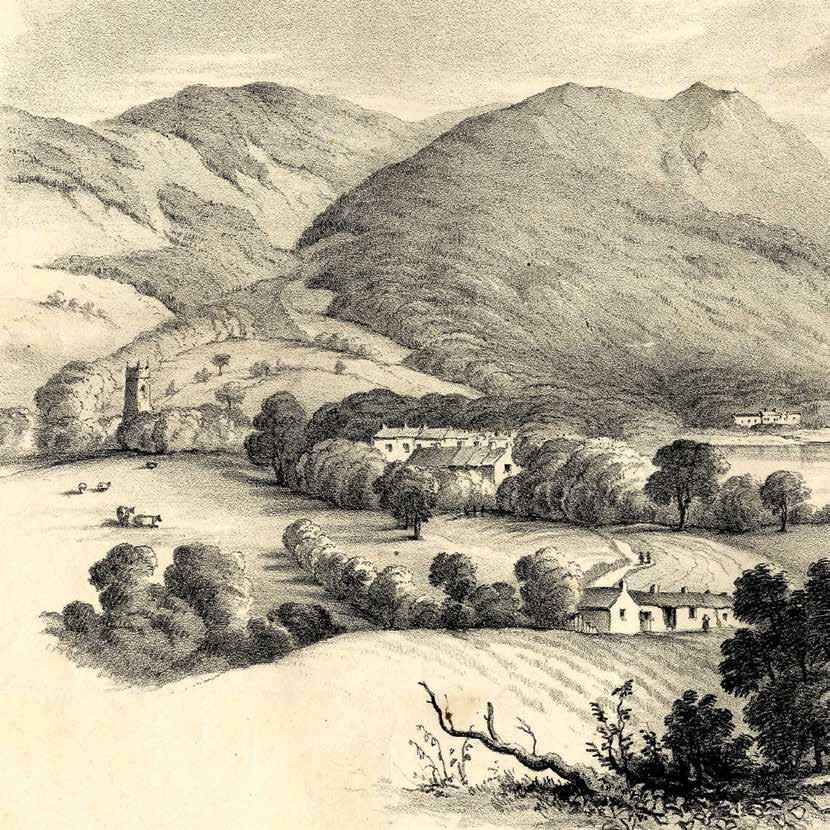
18

Acknowledgements
Thanks are due to the staff and volunteers of Newry and Mourne Museum for their assistance in this exhibition and accompanying booklet:
Martin Brogan
Joanne Cummins
Declan Carroll Caroline Hegerty
Liam Hughes
Conor Keenan
Greg McAteer
Amanda McKinstry
Anna Savage
Dympna Tumilty Dr. Robert Whan
We are grateful to Shane McGivern and Dr. Terence Dooley for contributing articles to this booklet.
Thanks also to the Northern Ireland Museum’s Council for the funds to conserve artefacts used in this exhibition.
Conservation of a number of items on display in this exhibition has been made possible by Newry and Mourne District Council’s contributions to the Landfill Communities Fund administered by Ulster Wildlife.
We would also like to extend a special thanks to those who contributed to the exhibition through donations, loans, expertise or memories including:
Fergus and Angelique Hanna Bell
Sir William Hall Sean Madden Thomas and Yvonne Magee
Ursula Mhic An tSaoir Anthony McGivern
Compiled by Noreen Cunningham, Dr. Ken Abraham and Shane McGivern
Every effort has been made to correctly attribute photographs used in this booklet and accompanying exhibition.
Detail from indenture, 1785 Signature and seal of Robert Ross, uncle of Major General Robert Ross, from an indenture by which leased land the townland of Levallyreagh to Robert Rainey of Newry.
Newry and Mourne Museum Collection

20
Ross Monument, Rostrevor
Erected in 1826, the obelisk is inscribed ‘Major-General Robert Ross served with distinction in Holland, Egypt, Italy, Spain and France; conquered in America and fell victorious at Baltimore’. The monument was restored in 2008 by Newry and Mourne District Council. There are also memorials to Ross in St. Paul’s Cathedral in London and in Kilbroney Parish Church.
 © William McAlpine
Back cover: Steel engraving, early 19th century The beautiful scenery of Rostrevor area made it a favourite subject for artists in the 19th century. Newry and Mourne Museum Collection
© William McAlpine
Back cover: Steel engraving, early 19th century The beautiful scenery of Rostrevor area made it a favourite subject for artists in the 19th century. Newry and Mourne Museum Collection
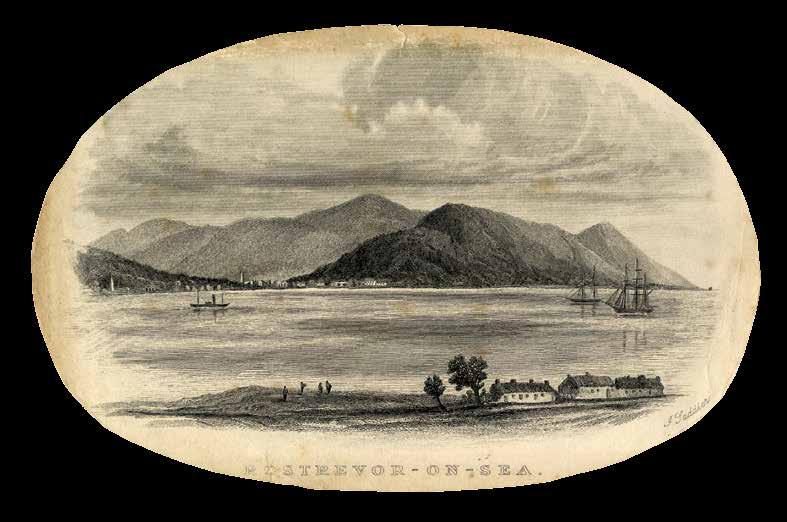




 Design: G. Watters
Design: G. Watters



















 © William McAlpine
Back cover: Steel engraving, early 19th century The beautiful scenery of Rostrevor area made it a favourite subject for artists in the 19th century. Newry and Mourne Museum Collection
© William McAlpine
Back cover: Steel engraving, early 19th century The beautiful scenery of Rostrevor area made it a favourite subject for artists in the 19th century. Newry and Mourne Museum Collection





 Design: G. Watters
Design: G. Watters